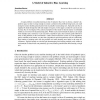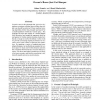68 search results - page 8 / 14 » Inductive Principles for Restricted Boltzmann Machine Learni... |
ICML
2008
IEEE
14 years 8 months ago
2008
IEEE
Deep Belief Networks (DBN's) are generative models that contain many layers of hidden variables. Efficient greedy algorithms for learning and approximate inference have allow...
JAIR
2000
13 years 7 months ago
2000
A major problem in machine learning is that of inductive bias: how to choose a learner's hypothesis space so that it is large enough to contain a solution to the problem bein...
ALT
2002
Springer
14 years 4 months ago
2002
Springer
In this paper we study the question of whether identifiable classes have subclasses which are identifiable under a more restrictive criterion. The chosen framework is inductive ...
KDD
2010
ACM
13 years 11 months ago
2010
ACM
We analyze the application of ensemble learning to recommender systems on the Netflix Prize dataset. For our analysis we use a set of diverse state-of-the-art collaborative filt...
IJCAI
2007
13 years 9 months ago
2007
Occam’s razor is the principle that, given two hypotheses consistent with the observed data, the simpler one should be preferred. Many machine learning algorithms follow this pr...


